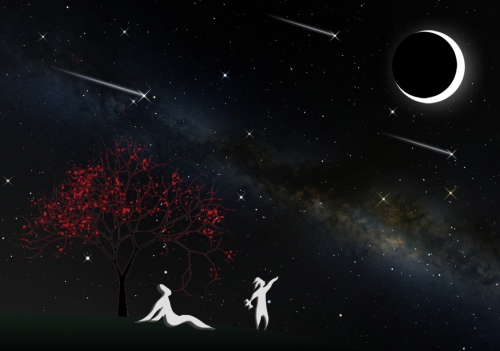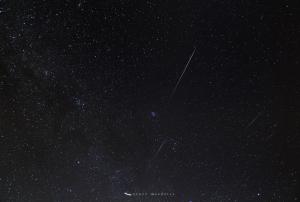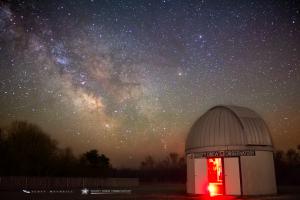
Stargazing Nights
- Where:
- Frosty Drew Observatory
- When:
- Friday April 19, 2019 from 7:00 - 9:00 pm
- Cost:
- $5 Suggested Donation per person 5 years and older
Tonight is Stargazing Night at Frosty Drew Observatory, and forecasts are calling for rain, fog, high winds, and clouds. At this point, we are just repeating ourselves with this endlessly unrelenting forecast for Friday nights. We can seek a little relief that all we are missing out on tonight is the Full Pink Moon, which will blaze intense moonlight into the atmosphere and block our view of most other objects. Though tempted to keep the Observatory and Sky Theatre closed tonight, we will defy the weather and open up with our cloudy night program.
The Observatory and Sky Theatre will open from 7:00 – 9:00 pm tonight. In the Observatory we will offer tours of our telescopes and operations, with the lights on. On the Observatory 40” panel we will show photos of celestial objects photographed at Frosty Drew Observatory. The Sky Theatre will be open as well with the same presentation of previously captured celestial objects, on the big screen. Our astronomers will offer up commentaries and entertain an open discussion on general astronomy.
Overall, we are setting into quite a long bout of depressing weather for astronomy. With well over a month of clouded out Friday nights, we are stressing the reality of spring in New England. If you’re making the long drive, then tonight is certainly the night to skip (again), though if in the local area, stop in for quite catch-up on all that’s happening in astronomy and lament with us the relentless Friday night cloud attack on Frosty Drew.
-----------------------------
Weekly Happenings
Scott MacNeill
Starting tonight (April 19-20), Jupiter begins to rise in the night hours before midnight, and will continue to rise earlier with each passing night. Though still a few weeks away from our first view of Jupiter during our regular Stargazing Nights hours, Jupiter has been visible in the morning hours for the past couple months. Jupiter will be the first of the bright naked eye visible planets coming into view for the 2019 viewing season. As we move into summer, Jupiter and Saturn, alongside the Milky Way, will be the rock stars of the night sky. Telescopic views of Jupiter bring the four Galilean Moons, the equatorial bands, and the Great Red Spot to life. Additionally, at Frosty Drew we will begin capturing images of Jupiter over the next couple weeks. Now is the time to get excited about fabulous views of the bright gas giants that are in store for us sky watchers this spring and summer!
This coming Monday morning (April 22, 2019), the annual Lyrid Meteor Shower peak will occur. Usually coinciding with Earth Day (April 22nd), the Lyrid shower brings an increase of about 18 meteors per hour to the night sky. The Lyrid shower appears to radiate from a spot just west of the bright star Vega in the constellation Lyra, which is where the shower gets its name from. The source of the shower is comet C/1861 G1 Thatcher, a long-period comet with a 415 year orbit around the Sun. Comet Thatcher leaves a debris field in its wake, mostly comprised of dust to rice sized particles of ice, which crosses Earth’s orbit. When Earth passes through the debris field, particles are captured by Earth’s gravity and burn up as they enter the atmosphere. The Lyrid shower is notable for a couple of reasons. This is the first moderate meteor shower to occur since the Quadrantid Meteors Shower on January 3rd, and kicks off meteor watching season, which brings a moderate to large meteor shower nearly every month through the end of the year. Secondly, the Lyrid shower peaks in the morning hours, which gets you out during the best time of the year to see the Milky Way, which is currently visible in the morning hours from dark locations. Sadly, the 2019 Lyrids will be accompanied by the bright 91% waning gibbous Moon, which rises at 10:16 pm on Sunday night (April 21, 2019), and will obscure all but the brightest meteors, as well as render our view of the Milky Way invisible. If you have clear skies and feel inspired, step outside in the morning hours after 1:00 am – pre-dawn, lay on your back, preferable in a way where the Moon is blocked from your view, and look to the zenith to catch meteors streaking by. Check out this photo we captured of the Milky Way over Frosty Drew Observatory during the Lyrid Meteor Shower peak in 2015.
This coming Monday, April 22, 2019 is Earth Day, and NASA is running it’s annual Earth Day celebration with the Picture Earth campaign. Capture a photo of your favorite natural feature. In RI this could easily be waves, coastline, cherry blossom, azalea or magnolia blooms, or even the fabulous night sky visible along the southern coastal locations. Post the photo to social media on Monday with the hashtag #PictureEarth. NASA will be sharing images all day. Though more importantly, be sure to take a moment on Monday to step outside and find a spot of happiness on this amazing planet, and think for a moment about how amazing it is to be alive and part of Earth. Have a fantastic Earth Day from all the astro geeks at Frosty Drew Observatory.



